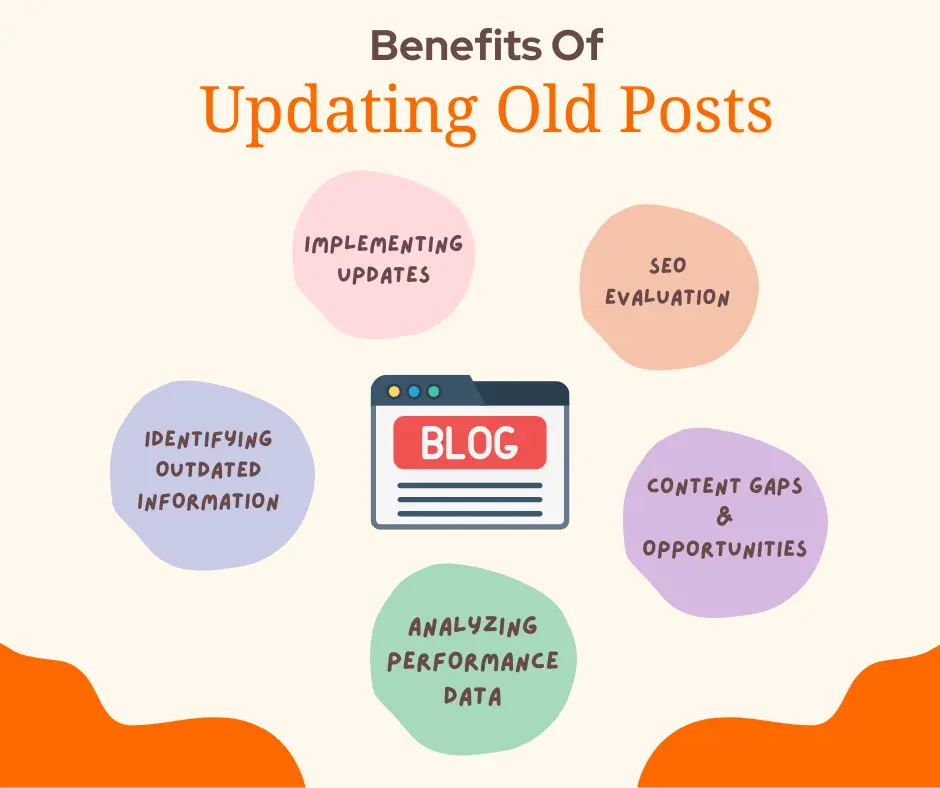Revitalizing Your Content Strategy: A Modern Guide to Repurposing Old Content

In the digital age, the creation and repurposing of content are pivotal for maintaining relevance and engagement. As search engines favor the freshness and relevance of content, updating old posts can significantly impact their ranking. Here’s how you can breathe new life into your content strategy:
1Audit and Update Old Posts
Conducting a comprehensive audit of your existing content portfolio is essential to pinpoint outdated, underperforming, or otherwise refresh-worthy material. This process involves a systematic review of all content pieces to assess their current relevance, performance metrics, SEO optimization, and alignment with your audience’s interests and search behavior. Key steps include:

Spot articles with outdated statistics, references, or content that no longer aligns with industry best practices. Utilize analytics tools to identify posts that are not performing well in terms of traffic, engagement, or conversions. Assess whether the content is optimized for current SEO best practices, including keyword usage, meta descriptions, and URL structures.
Look for opportunities to add value to existing content through expanded sections, updated insights, or incorporating multimedia elements.
Refresh the content with the latest data, research findings, expert quotes, and relevant multimedia. Also, ensure the post is re-optimized for SEO with current keywords and meta tags.
By systematically updating these elements, you can significantly enhance the relevance and visibility of your content. Updated posts not only stand a better chance of ranking higher in search engine results but also provide more value to your readers, leading to increased engagement and sharing. This strategy leverages the inherent value of the post’s age while ensuring the content remains dynamic and relevant.
2Transform Text into Visuals and Videos
To enhance the transformation of text into visuals and videos, consider the following:
Beyond Canva, explore platforms like Adobe Spark or Piktochart for more sophisticated design options. These tools offer templates specifically geared towards social media, presentations, and infographics, making it easier to convert complex information into visually appealing formats.
Develop a range of visual content, including quote graphics, data visualizations, and animated explainer videos. This variety caters to different audience preferences and increases engagement across platforms.
For video content, use tools like InVideo or Adobe Premiere Rush to edit and produce high-quality videos. Incorporating subtitles, engaging thumbnails, and a clear call-to-action can make your videos more effective.
When creating content for platforms like Instagram Stories or YouTube Shorts, focus on delivering value in a concise format. Use bullet points, short lists, or quick tips derived from your articles to keep the content snappy and digestible.
Consider creating interactive infographics with tools like Visme, which allow users to engage directly with the data through hover effects, clickable elements, or embedded quizzes.
By diversifying the formats and enhancing the visual appeal of your content, you can significantly broaden your reach and engagement, making complex topics accessible and interesting to a wider audience.
3Leverage AI for Content Updates
AI tools, through natural language processing and machine learning algorithms, can analyze vast amounts of data to uncover insights that might not be immediately apparent to human editors.
These tools can identify emerging trends, ensuring that your content is always aligned with what your audience is currently interested in.
By analyzing user behavior and content performance, AI can pinpoint exactly which topics are gaining traction and suggest specific angles or updates that could make older content more relevant and engaging.
Furthermore, AI can enhance SEO strategies by identifying the most effective keywords and phrases based on current search trends, suggesting internal linking opportunities to improve site structure, and even optimizing meta descriptions and titles to increase click-through rates. By leveraging these capabilities, content creators can ensure that their repurposed content not only meets the current needs and preferences of their audience but also adheres to the best practices of SEO, significantly boosting the visibility and reach of their updated content in search engine results.
4Engage Audience with Interactive Formats
Engaging your audience with interactive formats is a powerful strategy to not only repurpose your existing content but also to foster a deeper connection with your audience. By transforming your longer posts into interactive webinars, online courses, or live Q&A sessions, you can create a dynamic and immersive experience for your viewers.
- Webinars are an excellent way to engage your audience in real-time. They allow you to present your content in a live format, where you can share insights, discuss key points, and answer questions from participants as they come up. This real-time interaction helps in building a sense of community and trust, as your audience can see and hear you, making your content more relatable and trustworthy.
- Online Courses take engagement to the next level by providing structured, in-depth learning experiences. By breaking down your longer posts into modules or lessons, you can guide your audience through a comprehensive journey of your content. This not only helps in retaining their interest but also provides them with a systematic way to digest the information, ensuring a more profound understanding.
- Live Q&A sessions complement your content by offering an opportunity for direct interaction. This is a chance for your audience to ask specific questions related to your content, seek clarifications, and engage in meaningful discussions. It fosters a sense of community and allows your audience to feel heard and valued, which can lead to increased loyalty and trust in your brand or expertise.
Furthermore, these interactive formats provide a platform for real-time feedback. You can gauge the reactions and opinions of your audience, which can help you refine your content, adapt to their needs, and ensure that you’re delivering value. This feedback loop is invaluable for improving your content strategy and tailoring your future content to meet the expectations of your audience.
Converting your longer posts into interactive webinars, online courses, or live Q&A sessions offers multiple benefits. It keeps your content fresh and engaging, deepens the connection with your audience, and allows for real-time feedback and discussion. By embracing these interactive formats, you can create a more dynamic and impactful content marketing strategy that resonates with your audience on a whole new level.
5Utilize Social Media for Micro-Content
Harnessing the power of social media for micro-content has become even more critical for content creators and businesses looking to reach a wider audience and boost their online presence. Here are some updated insights and strategies to make the most of this approach:
-
Twitter Threads and LinkedIn Carousels:
Twitter threads and LinkedIn carousels have gained popularity as effective ways to break down lengthy content. These platforms now allow users to create threads and carousels that are not only visually appealing but also engaging. You can use them to share step-by-step guides, industry insights, or story-telling narratives, providing valuable information to your audience in a digestible format. -
Facebook Updates and Live Videos:
Facebook remains a potent platform for sharing micro-content. In addition to status updates, consider using live video sessions to interact with your audience in real-time. Live Q&A sessions or behind-the-scenes glimpses can be highly engaging and drive traffic to your comprehensive content. -
Instagram Stories, Reels, and IGTV:
Instagram continues to evolve its features for micro-content creators. Stories are ideal for sharing daily updates, while Reels provide a creative space for showcasing quick tips, tutorials, and visual summaries. IGTV can be used for longer-form content, allowing you to dive deeper into topics and provide in-depth insights. -
TikTok for Bite-Sized Content:
TikTok has risen as a prominent platform for short-form videos, making it perfect for creating catchy and informative micro-content. Utilize trending challenges, duets, or simply produce engaging 15-60 second videos to capture the attention of a younger and diverse audience. -
YouTube Shorts:
YouTube Shorts is YouTube's response to the growing popularity of short-form video content. It's an excellent platform for sharing quick tips, fun facts, or teaser snippets from your comprehensive content, attracting viewers who prefer short and snappy videos. -
Content Repurposing:
Repurposing your micro-content across various platforms can maximize its impact. Share snippets from your Twitter threads on Instagram, turn Facebook Live sessions into YouTube Shorts, or adapt LinkedIn carousels into blog posts. This cross-platform approach ensures that your content reaches different demographics. -
Data-Driven Strategies:
Use social media analytics to track the performance of your micro-content. Identify which types of content resonate most with your audience, the best posting times, and engagement metrics. This data-driven approach allows you to refine your content strategy for better results. -
Engagement and Interactivity:
Encourage audience engagement by posing questions, conducting polls, and soliciting feedback in your micro-content. Respond promptly to comments and messages, fostering a sense of community and trust with your followers. -
Consistency and Scheduling:
Develop a content calendar and schedule your micro-content in advance to maintain a consistent online presence. Utilize social media management tools to streamline your posting process and maintain a steady flow of engaging content. -
Collaboration and Influencer Marketing:
Partnering with influencers or collaborating with other content creators can help expand your reach. - Collaborative content can be shared across multiple platforms, allowing you to tap into new audiences and gain credibility within your niche.
The world of micro-content on social media continues to evolve rapidly. To stay relevant and effectively promote your comprehensive content, adapt to the latest features and trends on various platforms while keeping your audience’s preferences in mind. By doing so, you can drive traffic to your primary content, boost your online visibility, and engage with a broader audience.
6Employ Email Marketing for Renewed Reach
Employing email marketing for renewed reach is a strategic approach to reconnect with your existing subscribers and leverage your valuable content.
By crafting effective email campaigns, you can reintroduce updated content to your audience, enticing them to revisit your website and engage with your brand.
Here’s a more detailed look at how this strategy works:
-
Segmentation:
Start by segmenting your email list based on subscriber preferences, interests, and past interactions with your content. This allows you to tailor your email campaigns to specific audience segments, increasing the relevance of your message. -
Content Updates:
Identify the content that has been updated or improved since it was initially published. This could include new research findings, updated statistics, additional insights, or any other enhancements that make the content more valuable or relevant. -
Compelling Subject Lines:
Craft attention-grabbing subject lines that highlight the key benefits of revisiting your content. Use persuasive language to pique curiosity and encourage recipients to open your emails. -
Personalization:
Personalize your email content by addressing subscribers by their first name and referencing their previous interactions with your website or content. Personalization creates a sense of connection and engagement. -
Content Teasers:
In the email body, provide teasers or snippets of the updated content. Highlight the most compelling and relevant parts, emphasizing the added value or new insights that readers can gain by revisiting your website. -
Call to Action (CTA):
Include clear and compelling CTAs that prompt readers to click through to your website. Use action-oriented language that conveys the benefits of revisiting the content. -
Newsletter Integration:
Consider incorporating the content updates into your regular newsletter. This ensures that your email subscribers are consistently exposed to your refreshed content and can easily access it. -
Visual Appeal:
Use visually appealing elements in your emails, such as images, infographics, or videos, to make the content more engaging and shareable. -
Timing and Frequency:
Determine the optimal timing and frequency for your email campaigns. You may want to send reminders about updated content periodically, ensuring that subscribers have multiple opportunities to engage. -
Analytics and Tracking:
Implement email tracking and analytics tools to monitor the performance of your email campaigns. Pay attention to open rates, click-through rates, and conversion rates to assess the effectiveness of your strategy.
By employing email marketing in this manner, you not only increase traffic to your website but also reinforce your brand’s authority in your industry. Subscribers who find value in your updated content are more likely to view your brand as a reliable source of information and expertise. Over time, this can lead to increased trust, loyalty, and a stronger presence in your niche.
Final Thoughts
Content repurposing is a dynamic strategy that capitalizes on digital tools, AI, and creative approaches to extend the reach and impact of your content. The ultimate goal is to cultivate a content ecosystem that remains vibrant, relevant, and valuable to your audience over time. By continually optimizing and adapting your content, you can maintain a strong online presence and consistently meet the needs of your audience in an ever-evolving digital landscape.
About the Author

Kevin Bossons
Senior Digital Strategist
With over 15 years of experience in digital marketing and search engine optimization, Kevin has grown from an SEO contractor to Senior Digital Strategist at WT Digital Agency.